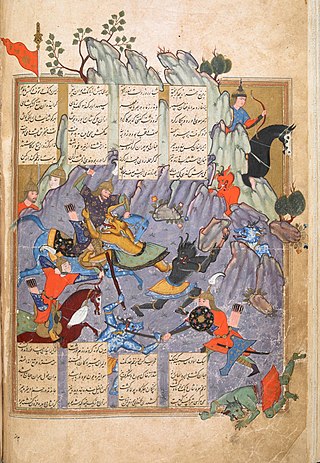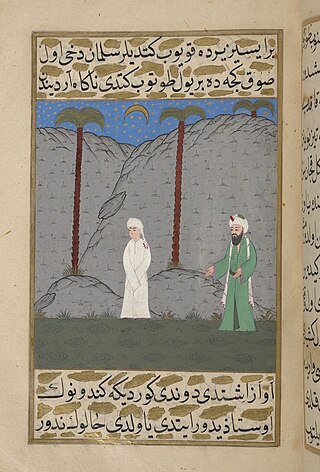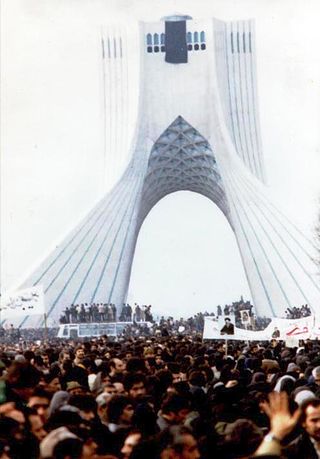Mah farvardin Ruz khordad is a book written in Middle Persian in the 7th century CE. It was written ca. 607-608 CE, during the reign of Khosrau II.
This book described all the events which historically or mythically occurred on the 6th day of the Persian month of Farvardin.

Nowruz is the Iranian New Year or Persian New Year. Historically, it has been observed by Persians and other Iranian peoples, but is now celebrated by many ethnicities worldwide. It is a festival based on the Northern Hemisphere spring equinox, which marks the first day of a new year on the Solar Hijri calendar; it usually coincides with a date between 19 March and 22 March on the Gregorian calendar.

Adherents of Zoroastrianism use three distinct versions of traditional calendars for liturgical purposes. Those all derive from medieval Iranian calendars and ultimately are based on the Babylonian calendar as used in the Achaemenid empire. Qadimi ("ancient") is a traditional reckoning introduced in 1006. Shahanshahi ("imperial") is a calendar reconstructed from the 10th century text Denkard. Fasli is a term for a 1906 adaptation of the 11th century Jalali calendar following a proposal by Kharshedji Rustomji Cama made in the 1860s.
The Baháʼí calendar used in the Baháʼí Faith is a solar calendar consisting of nineteen months and four or five intercalary days, with new year at the moment of Northern spring equinox. Each month is named after a virtue, as are the days of the week. The first year is dated from 1844 CE, the year in which the Báb began teaching.

Abu Nasr Ali ibn Ahmad Asadi Tusi was a Persian poet, linguist and author. He was born at the beginning of the 11th century in Tus, Iran, in the province of Khorasan, and died in the late 1080s in Tabriz. Asadi Tusi is considered an important Persian poet of the Iranian national epics. His best-known work is Garshaspnameh, written in the style of the Shahnameh.

Salman al-Farsi was a Persian religious scholar and one of the companions of Muhammad. As a practicing Zoroastrian, he dedicated much of his early life to studying to become a magus, after which he began travelling extensively throughout West Asia to engage in constructive dialogue with non-Zoroastrian groups. His quests eventually prompted his conversion to Christianity and later his conversion to Islam, which occurred after he met and befriended Muhammad in the city of Yathrib. He was a prominent non-Arab companion and one of Muhammad's closest friends; Muhammad had once stated to a gathering of his followers that he regarded Salman as a part of his family. In meetings with the other companions, he was often referred to by the kunyaAbu ʿAbdullah.
Middle Persian literature is the corpus of written works composed in Middle Persian, that is, the Middle Iranian dialect of Persia proper, the region in the south-western corner of the Iranian plateau. Middle Persian was the prestige dialect during the era of Sasanian dynasty. It is the largest source of Zoroastrian literature.

Aries (♈︎) is the first astrological sign in the zodiac, spanning the first 30 degrees of celestial longitude, and originates from the Aries constellation. Under the tropical zodiac, the Sun transits this sign from approximately March 21 to April 19 each year. This time-duration is exactly the first month of the Solar Hijri calendar.

Mah Sharaf Khanom Mastoureh Ardalan or Mastura Ardalan was a Kurdish poet, historian, and writer.

Kīmīyā-yi Sa'ādat is a book written by Abū Ḥāmid Muḥammad ibn Muḥammad al-Ghazālī, a Persian theologian, philosopher, and prolific Muslim author, often regarded as one of the greatest systematic thinkers and mystics of Islam, in Persian. The Kimiya-yi Sa'ādat was written towards the end of his life shortly before 499 AH/1105 AD. During the time before it was written, the Muslim world was considered to be in a state of political, as well as intellectual unrest. Al-Ghazālī, noted that there were constant disputes about the role of philosophy and scholastic theology, and that Sufis became chastised for their neglect of the ritual obligations of Islam. Upon the release of this book, the Kimiya-yi sa'ādat allowed al-Ghazali to considerably cut the tensions between the scholars and mystics. Kimiya-yi sa'ādat emphasized the importance of observing the ritual requirements of Islam, the actions that would lead to salvation, and avoidance of sin. The factor that set the Kimiya-yi sa'ādat apart from other theological works at the time was its mystical emphasis on self-discipline and asceticism.
Farvardin is the Iranian Persian name for the first month of the Solar Hijri calendar, the official calendar of Iran, and corresponds with Aries on the Zodiac. Farvardin has thirty-one days. It is the first month of the spring season (Bahar), and is followed by Ordibehesht. The Afghan Pashto name for it is Wray.

Sizdah Bedar, also known as Nature's Day, is an Iranian festival held annually on the thirteenth day of Farvardin, the first month of the Iranian calendar (and the first month of spring, during which people spend time picnicking outdoors. It marks the end of the Nowruz holidays in Iran.
Naw-Rúz is the first day of the Baháʼí calendar year and one of eleven holy days for adherents of the Baháʼí Faith. It occurs on the vernal equinox, on or near March 21, which is also the traditional Persian New Year.
Iranian folklore encompasses the folk traditions that have evolved in Greater Iran.
Zoroastrianism is recognized in the Baháʼí Faith as one of nine known religions and its scriptures are regarded as predicting the coming of Baháʼu'lláh. Zoroaster is included in the succession of Manifestations of God. The authenticity of the Zend Avesta is seen as uncertain.
Peroz II, also known as Gushnasp-Bandeh was king of Persia. He was son of Mah-Adhur Gushnasp and Kahar-dukht, who was daughter of Yazdandad son of Khosrau I. Peroz II reigned only for a short time in 631 CE, until he was killed by Sasanian nobles.
Majid Adibzadeh is an Iranian writer.

Iranian Islamic Republic Day is Farvardin 12, known as Ruz e Jomhuri ye Eslāmi. The day is a national and a public holiday in Iran. It marks the day that the results of the 1979 Iranian Islamic Republic referendum were announced. The results announced were a 98.2% vote for the establishment of an Islamic republic in the state.

The Fajr decade is a ten-day celebration of Ruhollah Khomeini's return to Iran in 1979. The annual celebration is held between 1 and 11 February. Its beginning coincides with the date of Khomeini's arrival and ending with the Iranian Revolution; a day called the Anniversary of the Iranian Revolution, Islamic Revolution's Victory Day, or 22 of Bahman.

Tarikh-i Bal'ami or Tārīkhnāma-yi Bozorg is the earliest known extant prose book in the Persian language written by Muhammad Bal'ami, a vizier in Samanid service. The 10th-century text is a universal history, spanning a period beginning with the dawn of creation through to the Islamic age. Having been translated into Turkish and Arabic, the book remained in circulation for a thousand years, and it is among the most influential books of Islamic historical literature. While the author claims the book is a Persian translation of al-Tabari's History of the Prophets and Kings, it is actually an independent work.

Manichaean scripture includes nine main books: the Seven Treatises of Manichaeism, all personally written by Mani in Syriac, the Shabuhragan written by Mani in Middle Persian, and the Arzhang, a series of illustrations painted by Mani.